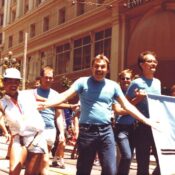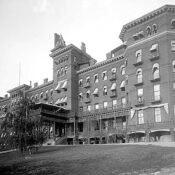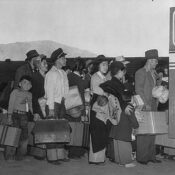Can you pinpoint the exact moment that a musical movement peaks? It’s easy to define music to nonspecific eras: you have the British Invasion, the early 1990s Alternative Explosion, and so on. However, the unassailable peak of disco happened the week of July 21, 1979, when the top six songs in the U.S. (and seven in the Top Ten) were classified as disco tunes. Over the following few weeks, every trace of the style would vanish from the charts. This is the story of a genre’s rise, greatest moment of triumph, and fall.
An exact date for the creation of disco is impossible to pin down, but we can trace its development from earlier decades to the 1970s. One significant step in the genre’s development was the ongoing slate of private parties hosted by New York DJ David Mancuso at his home starting in 1970. Mancuso’s approach was copied by others; as his own “The Loft” became the epicenter of a new dance culture, it spread into other private parties and clubs. The Loft was notable for the blended audiences that it attracted; no barriers were placed on ethnicity or sexuality, and the music had to be danceable and generally celebratory.
The sound of disco came from a variety of places. Motown R&B played a part, as did the soul stylings of groups from cities like Philadelphia, like The O’Jays and The Stylistics. Producers like Tom Moulton pushed the record format when it came to dance, extending single lengths by using 12” vinyl and innovating the remix approach that added or enhanced elements of songs. The psychedelic soul sound associated with later Temptations records and the funk of George Clinton’s Parliament-Funkadelic added other ingredients to the brew.
The O’Jays perform “Love Train” (Uploaded to YouTube by the O’Jays)
From a cultural standpoint, the shift from the 1960s to the 1970s opened the door for new things. As the counterculture movement died off and Vietnam continued, economic uncertainty plagued the country. The ongoing social turmoil became a crucible for new and reinvented forms of music, including the evolution of heavy metal, punk, hip-hop, and disco. In the book Beautiful Things in Popular Culture, Simon Frith said, “The driving force of the New York underground dance scene in which disco was forged was not simply that city’s complex ethnic and sexual culture, but also a 1960s notion of community, pleasure and generosity that can only be described as hippie. The best disco music contained within it a remarkably powerful sense of collective euphoria.” Soon dance records that broke in the clubs found success on the radio and in record stores, adding some early fuel to the movement.
“Rock the Boat” by The Hues Corporation (Uploaded to YouTube by The Hues Corporation / RCA Victor)
On the charts, a number of songs that could arguably be classified as disco emerged as hits in the very early 1970s. Among these were “Love Train” by The O’Jays (1972) and “Love’s Theme” by Barry White’s The Love Unlimited Orchestra (1974). When “Rock the Boat” by The Hues Corporation hit #1 in May of 1974, many declared it to be the first disco #1, though others held up “Love’s Theme” (which topped the charts in February) as the first. Regardless of which was “first,” it was evident that the style had a place on the charts and was primed to grow. Carl Douglas’s “Kung-Fu Fighting” and George McRae’s “Rock Your Baby” also hit #1, with “Rock” having the added distinction of being the first disco #1 in the U.K. The success of disco rolled into 1975, with landmark tracks like Van McCoy’s “The Hustle” and the commercial breakthroughs of Donna Summer and KC and The Sunshine Band.
“Night Fever” by The Bee Gees (Uploaded to YouTube by beegees)
The popular acceptance of the form took it into more mainstream clubs and into film and television. A 1976 New York magazine article inspired the disco-driven 1977 film Saturday Night Fever. The already popular Bee Gees had turned their attention to more dance-oriented sounds by 1975, and the trio had created hits like “Jive Talkin’” and “You Should Be Dancing” (1976). The Bee Gees agreed to craft songs for the film; those tunes, as well as songs they wrote for others and contributions from different acts, would form one of the best-selling soundtracks in history. The success of the Oscar-nominated movie and the soundtrack (over 16 million albums sold) remarkably elevated the profile of the genre to even greater heights.
Between 1977 and 1980, roughly 22 songs that fit into the disco genre hit number one on the Billboard Hot 100. These included obvious numbers like “I Will Survive” by Gloria Gaynor and “Dancing Queen” by Abba, as well as critically acclaimed pieces “Don’t Leave Me This Way” by Thelma Houston (a cover of a Harold Melvin & The Blue Notes song, Houston’s version won a Grammy for Best Female R&B Vocal Performance in 1977).
“Don’t Leave Me This Way” by Thelma Houston (Uploaded to YouTube by Thelma Houston)
Despite the popularity of the form, there were definitely dissenters. One of them was Steve Dahl, a rock DJ who lost his job at Chicago’s WDAI when the station switched from a rock format to disco. Dahl was hired by WLUP and worked hard to stir anti-disco backlash. After promoting a few events, Dahl participated in a promotion at Comiskey Park, home of the White Sox. Disco Demolition Night on July 12, 1979, encouraged fans to bring disco records to the double-header between the Sox and Tigers where the discs would be blown-up in center field. The event got out of hand early when fans that couldn’t get into the sold-out affair broke into the stadium anyway. Beer, firecrackers, and albums rained on the field throughout the first game. After the crate of records was detonated between contests, thousands of fans rushed the field. Police were called, and eventually the White Sox had to forfeit the game (it’s the last American League behavior-forfeit on record). While many, like Dahl, dismissed the circumstances of the event as harmless fun gone out of hand, others like Rolling Stone writer Dave Marsh expressed that a lot of the hostility toward disco included bigotry toward black, Latino, and gay artists and fans.
“Hot Stuff” by Donna Summer (Uploaded to YouTube by Donna Summer Universal Music Group
Despite the anti-disco sentiment, a few days after the Comiskey Park incident, the Billboard Charts reflected the week of peak disco. Seven of the Top Ten were disco tracks, including: “Bad Girls” by Donna Summer (#1); “Ring My Bell” by Anita Ward (#2); “Hot Stuff” by Summer (#3); “Good Times” by Chic (#4); “Makin’ It” by David Naughton (#5); “Boogie Wonderland” by Earth, Wind, & Fire with The Emotions (#6); and “Shine A Little Love” by Electric Light Orchestra (#8). ELO, like Blondie, weren’t a traditional disco band, but did release songs that employed the sound. Despite this high, disco was about to hit its inglorious low.
“My Sharona” by The Knack (Uploaded to YouTube by The Knack / Universal Music Group)
On August 25, “My Sharona” by The Knack began a six-week run at #1. Critics typically lump The Knack in with “new wave” rock acts that also included multi-genre stylists Blondie, Elvis Costello, and others. Disco would continue to dot the charts for a while, but the cultural backlash caused many artists to simply relabel themselves as “dance.”
When MTV kicked off in 1981, it effectively killed disco for good in two ways. The first is the unfortunate reality that that the network played very little in the way of black artists in its early days. The second is that the channel embraced bands that were already making videos or working overseas (where the “video clip” format was already popular), resulting in a massive push for predominantly white, new-wave-related bands and English bands. Everyone seems to know that the first video played on MTV was “Video Killed the Radio Star” by The Buggles, but the next nine were from Pat Benatar, Rod Stewart, The Who, Ph.D., Cliff Richard, The Pretenders, Todd Rundgren, REO Speedwagon, and Styx. Black artists wouldn’t break through on the channel until the massive success of Michael Jackson and Prince in the following two years forced the network to catch up.
Gloria Gaynor’s “I Will Survive” enjoys ongoing life in other media and sporting arenas. (Uploaded to YouTube by Gloria Gaynor / The Orchard Enterprises)
Today, disco culture is a staple of films and TV, as seen in everything from Boogie Nights to Pose to The Martian (Matt Damon’s character may have hated it, but Jessica Chastain’s loved it). The musical style has adapted and integrated into a variety of genres, including EDM and hip-hop, where sampled hooks are still regularly mined from disco classics. Package tours of disco artists continue to circulate. The influence is felt in a number of popular songs of the past few years, among which are Daft Punk’s “Get Lucky” (which features Nile Rodgers of Chic), “Uptown Funk” by Bruno Mars, and “Can’t Feel My Face” by the Weeknd. Disco may never have a proper, world-dominating comeback, but it never truly went away. It’s fair to say that no matter how you try to kill it, it will survive.
Become a Saturday Evening Post member and enjoy unlimited access. Subscribe now



Comments
As a former disco DJ I had no hard feelings towards MTV or VH1. Rock infiltrated disco with many hits like I Will Follow by U2, J Geils Band, Rod Stewart, Rolling Stones, Paul McCartney, AC/DC, Queen, Hall & Oates, & others that started the new wave craze. I pretty much embraced everything because it was still rockin. As a matter of fact, clubs in San Francisco with a diversified wide audience would often mix many genres in one evening and if the DJ was talented enough, it would mix together seamlessly.
Even #KKDJ, a classic rock station that broadcasts music videos over television and online plays occasional crossover disco and new wave.
Twitter Robert J Romero 4.
Thanks for reading, Bob; glad you enjoyed it.
This IS a fascinating look back at mostly great music. The O’Jays (’72) smash hit ‘Love Train’ seems much more ‘soul’ than ‘disco’ to be fair, and the instrumentals MFSB-TSOP (Sounds of Philadelphia) following “Love’s Theme” really seemed to usher in the official disco sound, which REALLY took off from there in early-mid 1974.
Soon there was ‘Rock the Boat’ going to #1, “Rock Your Baby”, “Never Can Say Goodbye” by Gloria Gaynor (very underrated compared to Gaynor’s ’79 “I Will Survive” 5 years later.) Carl Douglas’s “Kung-Fu Fighting” was/is so bad I’m not sure what category it fits into. Hated it at 17 in ’74 almost as much as ‘Sweet Home Alabama’ (still do in 2019—ugghk)!
Then we move into ’75 where the whole thing burst wide open with ‘The Hustle’ and KC and the Sunshine Band’s string of hits. The Bee Gees of course were just getting warmed up with ‘Jive Talkin’ and ‘You Should Be Dancing’ before the ‘Saturday Night Fever’ roll. Lest we not forget ‘Disco Lady’ and ‘Get Up and Boogie’ in ’76! How about ‘A 5th of Beethoven’?
In ’77, disco wasn’t about to be dumped on a dark desert highway or anywhere else. There were a lot of great choices in music back then; especially from my favorites ELO, Styx and the Eagles. It did get to be too much with the first half of ’78 nearly completely dominated by the ‘Fever’ soundtrack. Then, like a brush of fresh air, came The Sweet’s ‘Love Is Like Oxygen’! Really love the long version. ‘Count On Me’ sung by Marty Balin? Beautiful.
Most of the top 10 songs of that week of July 21, 1979 were quite good, likable, and hold up well today! ‘Bad Girls’, ‘Hot Stuff’, ‘Ring My Bell’, ‘Makin’ It’, ‘Boogie Wonderland’ and naturally ELO’s ‘Shine A Little Love’ with that one-of-a-kind “cascading downward” electric keyboard sound effect. Priceless. Great in concert now too—just saw them again last month! I appreciate your clarifying ‘Shine’ wasn’t disco, but incorporated some elements.
I hated ‘My Sharona’ from the first time I ever heard it, and do to this day. Fortunately, I can detect it in a couple seconds and be gone with it. For the purpose of this feature, I can see why it was included, unfortunately. It must be remembered that the still futuristic, cutting-edge sound of my premiere New Wave Band, The Cars, came out in late ’78, with the incredible ‘Candy-0’ followup having been released in June 1979.
A collaboration of sheer brilliance all around, Candy-0 remains an almost ‘Best of the Cars’ masterpiece. An interesting report this is Troy, showing the ’70s had distinctive sections all within the same decade musically and otherwise, like the ’60s and ’50s preceding them.